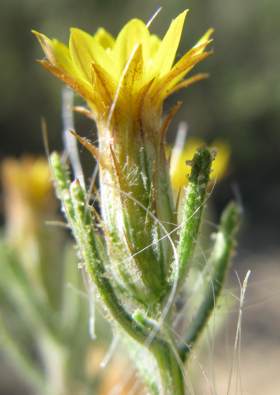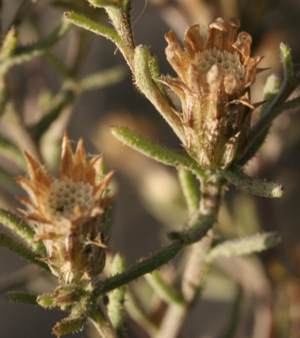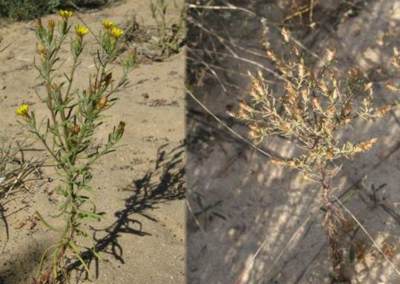Nestlera biennis
Nestlera biennis (Jacqu.) Spreng.
Family: Asteraceae
Common names: None known
Introduction
Nestlera biennis is a small, nondescript and short-lived plant with a very specific habitat on the west coast of South Africa. Although not showy or beautiful, it is one of the many indigenous species that contributes to the extraordinary biodiversity of the southern African region.

Description
Description
Nestlera biennis is a small, shrubby annual or biennial plant growing up to about 0.5m high. It is single-stemmed and sparsely branched, with small, narrow, slightly fleshy leaves that are covered in large stalked glands. The plants appear in springtime and bear small yellow daisy flowers at the ends of the shoots.

Their natural habitat begins to dry out soon and the plants rush to set seed before they die, being shallow-rooted and unable to withstand the summer drought on the arid west coast. The fruits are tiny, dry and narrow, topped by a small, bone-white tube or pappus and are shed in summer.

Conservation Status
Status
Nestlera biennis is Red Listed as Least Concern but occurs in sandy areas on the coastal platform that may be threatened by habitat transformation.
Distribution and habitat
Distribution description
This species occurs in sandy habitats on the coastal platform from Atlantis northwards to Namaqualand. It grows in very sandy, well-drained soil in strandveld, coastal fynbos and succulent karoo vegetation.

Derivation of name and historical aspects
History
There is only one species in the genus Nestlera. The generic name commemorates C.G. Nestler, professor of Botany and Pharmacology in Strasbourg in the early 19th century. The species epithet biennis is a Latin word meaning biennial, a plant that lives for two years or seasons (contrast with annual, a plant that lives for only a single season, and perennial, a plant that lives for several seasons). The genus Nestlera historically contained several other species, which have since been transferred to the strictly perennial genera Relhania, Oedera and Rosenia. Nestlera is a member of the Relhania clade and is in fact most closely related to the annual members of this clade, in the genera Leysera and Rhynchopsidium. These genera also occur in Namaqualand and in the Great Karoo of South Africa, with one species in North Africa.
Ecology
Ecology
The ecology of this plant is linked to its short lifespan and the need to set seed during a single season. Nestlera biennis germinates with the first spring rains and plants can flower when only a few centimetres high. If it is a wet spring, the plants can continue to grow and flower, and, given a sufficiently moist season or a particularly favourable growing site, the plants can continue to grow for a second year, flowering again the second spring. It is not known how Nestlera biennis is pollinated or even whether it is able to self-pollinate, although it has been photographed with a small wasp visitor. The seeds are long and thin which probably helps them to become stuck in the sand; they possess no mechanisms for dispersal, probably relying on the fact that the parent plant is not going to survive the dry season, which enables them to take over the same favourable site.

Uses
Use
There are no documented cultural uses for Nestlera biennis, although it comes from a group with members which have been used to make a pleasant tea (Athrixia - bush tea). The leaves have glandular hairs and are very aromatic. Nestlera biennis is not a highly attractive plant, especially when it begins to die back and set seed at the end of the growing season, so it has not been used in horticulture.
Growing Nestlera biennis
Grow
Although this species has not been much cultivated, it is likely to be very easy to propagate from seed given sufficient moisture and plenty of sun. Sow in late winter or spring in pure sand, feed well, and keep moist throughout the growing season. This plant is likely to continue to grow and produce flowers while conditions are favourable. Nestlera biennis is likely to make an interesting feature in rock gardens and dry borders, and should do well in places with low humidity and hot summers.
References
- Bremer, K. 1976. The genus Relhania (Compositae). Opera Botanica 40.
- Busch, B. & Bergh, N.G. 2013. An interactive digital key to the Relhania clade of southern African daisies using Delta / Intkey. B-test version. South African National Biodiversity Institute.
- Koekemoer, M. 2012. Key to the southern African species of the Relhania and Macowania groups in the Gnaphalieae (Asteraceae). Lucid Keys http://keys.lucidcentral.org/key-server/data/04040f0a-0603-4405-880c-010703060006/media/Html/default.html
Credits
Nicola Bergh
The Compton Herbarium
February 2014
Plant Attributes:
Plant Type: Bi/Annual
SA Distribution: Northern Cape, Western Cape
Soil type: Sandy
Flowering season: Spring
PH: Acid, Alkaline
Flower colour: Yellow
Aspect: Morning Sun (Semi Shade)
Gardening skill: Average
Special Features:
Horticultural zones









Rate this article
Article well written and informative
Rate this plant
Is this an interesting plant?
Login to add your Comment
Back to topNot registered yet? Click here to register.